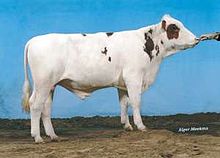Meuse-Rhine-Issel
| Other names |
|
|---|---|
| Country of origin | Netherlands |
| Use | dairy |
| Traits | |
| Weight |
|
| Height | |
| Coat | red pied, often with little red[5] |

The Meuse-Rhine-Issel or Meuse-Rhine-Yssel (Dutch: Maas-Rijn-IJssel) is a Dutch breed of dual-purpose cattle, reared both for meat and for milk.[6][7] It falls within the Lowland-Pied group of North European cattle; it is red-pied, and of medium-large size.[8]: 45
History
The Meuse-Rhine-Issel developed principally in two areas of Holland: the eastern part of the
It was registered in the
Numbers are in steep decline: in the 1970s there were more than half a million of the cattle, representing approximately a quarter of the total number of dairy cattle in the Netherlands; numbers fell to 31000 in 1999 and to 14000 in 2004.[9]: 142 [10] In 2021 the total population reported to DAD-IS was 9938.[3] Over 925000 doses of semen are kept in cryo-conservation; they represent almost 250 bulls, of which about one-fifth are from before 1980.[7]
In the twentieth century the Meuse-Rhine-Issel was one of the five breeds approved for
Characteristics
The Meuse-Rhine-Issel falls within the Lowland-Pied group of North European cattle; it is red-pied, and of medium-large size.[8]: 45
References
- ISBN 9789251057629. Archived 23 June 2020.
- ^ [s.n.] (26 June 2020). Rassenlijst Nederlandse landbouwhuisdierrassen (in Dutch). Wageningen: Centrum voor Genetische Bronnen Nederland. Accessed May 2022.
- ^ a b Breed data sheet: Maas-Rijn-IJssel / Netherlands (Cattle). Domestic Animal Diversity Information System of the Food and Agriculture Organization of the United Nations. Accessed May 2022.
- ^ ISBN 9781780647944.
- ^ Maas-Rijn-IJsselvee (MRIJ) (in Dutch). Wageningen: Stichting Zeldzame Huisdierrassen. Accessed May 2022.
- ^ a b c Yvette de Haas, Rita Hoving-Bolink, Myrthe Maurice-van Eijndhoven, Debbie Bohte-Wilhelmus, Henk Sulkers, Sipke-Joost Hiemstra (2009). MRIJ breed assessment. Wageningen: Centre for Genetic Resources, the Netherlands = Centrum voor Genetische Bronnen Nederland. Accessed May 2022.
- ^ a b Henri Woelders, Ina Hulsegge, Henk Sulkers, Rita Hoving, Sipke-Joost Hiemstra (2009). Cryoconservation of cattle breeds in The Netherlands. Wageningen: Centre for Genetic Resources, the Netherlands = Centrum voor Genetische Bronnen Nederland. Accessed May 2022.
- ^ ISBN 9781780642215, pages 33–66.
- . Accessed May 2022.
- ^ Meuse-Rhine-Yssel cattle (MRY). EuReCa. Accessed May 2022.
- ISBN 9789054390176.
